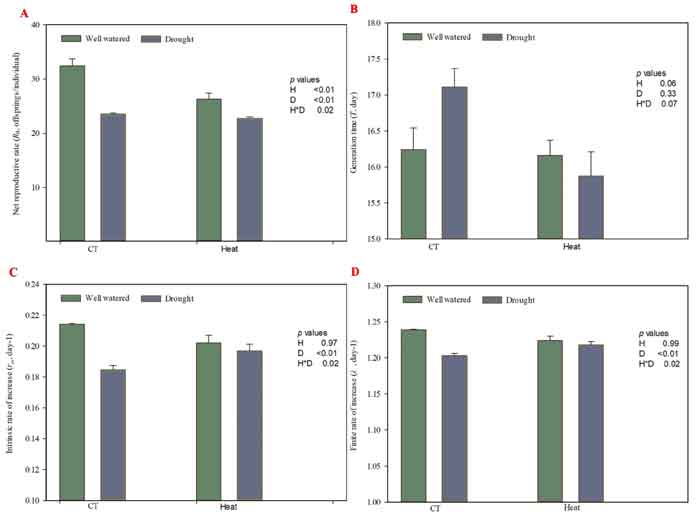| Tweet | Follow @co2science |
Paper Reviewed
Xie, H., Shi, J., Shi, F., Xu, H., He, K. and Wang, Z. 2020. Aphid fecundity and defenses in wheat exposed to a combination of heat and drought stress. Journal of Experimental Botany 71: 2713-2722.
Writing as background for their work Xie et al. (2020) say that "clarifying the expected changes in plant-insect interactions under combined heat and drought stress is an important objective in order to reduce insect damage to crops." And so it was that this team of six Chinese researchers set out to conduct their own plant-insect study to gain such clarification.
Their study involved quantifying the impacts of two abiotic stresses (heat and drought) on the nutritional quality and phytohormone-dependent defenses in wheat, as well as the performance of an aphid population reared on the wheat. In accomplishing their design, the scientists grew wheat seedlings in controlled environment chambers under four treatment conditions: (1) control (no stress applied), (2) heat stress (+8°C warming during 4 hours each day), (3) drought stress (10% soil water content compared to control of 20% soil water content) and (4) combined heat and drought stress. Aphid exposure was introduced at the two-leaf stage where wingless grain aphids (Sitobion avenae) were applied to the different treatments.
In discussing their findings Xie et al. report that both heat and drought stress impacted the soluble sugar content of the plants. Relative to control, for example, under heat stress the glucose and sucrose concentrations in the wheat plants increased by 12% and 27%, respectively. Similarly, drought stress enhanced fructose, glucose, sucrose and total sugar contents by 23%, 26%, 41% and 23%. However, the interaction between heat and drought on soluble sugars was not significant.
The scientists also note that amino acid accumulation in the wheat plants was enhanced by the two abiotic stresses, which when combined with the soluble sugar observations, led them to conclude that, overall, "the nutritional quality of wheat was improved by heat and drought stress."
With respect to the direct and indirect impacts of heat and drought on S. avenae, Xie et al. write that "heat and drought stress changed the interaction between wheat plants and grain aphids, mainly through the enhanced defense response and lower relative water content of host plants, but possibly also as a direct effect of heat stress on grain aphids." With respect to the former, heat and drought stress increased abscisic acid levels and the abundance of jasmonic acid- and salicylic acid-dependent defenses. With respect to the latter, the authors report "aphids reared on plants grown under drought stress alone showed lower net reproductive rates, intrinsic rates of increase, and finite rates of increase compared with aphids reared on plants in the absence of stress" (see Figure 1). Additionally, heat-treated plants showed a decline in aphid net reproductive rate. Consequently, in light of all of the above findings, Xie et al. conclude that in the future if temperatures rise and/or drought becomes more prevalent, "fewer resources will need to be dedicated to remediating aphid infestations of wheat" because the infestations will not likely be as severe as they are presently. And this likelihood is a lot more optimistic (and probably realistic) than the typical gloom and doom scenario put forth by climate alarmists.

Figure 1. Life parameters of aphids reared on wheat grown under heat and drought conditions. (A) Net reproduction rate; (B) generation time; (C) intrinsic rate of increase; (D) finite rate of increase. Each value represents the mean ± SE of three replicates. P values are provided for two-way ANOVA on the effects of heat (H) and drought (D) treatments on relative water content. CT = control temperature. Source: Xie et al. (2020).




